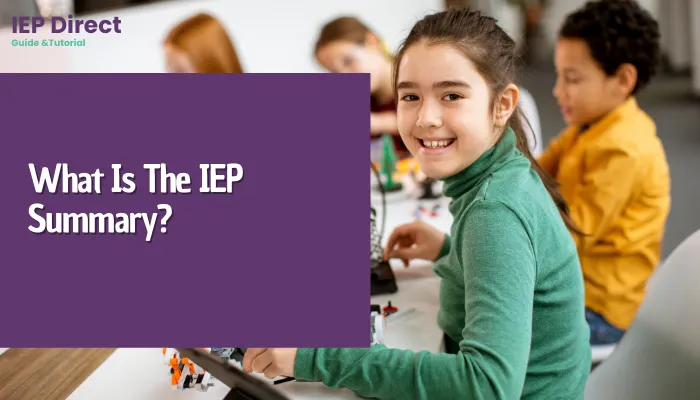So, we’ve talked about IEP, but what is the IEP Direct summary? Think of it as a condensed version of the full IEP. It’s a snapshot that highlights the most important information. While the full IEP can be quite lengthy and detailed, the IEP Direct summary provides a quick and easy-to-understand overview.
In essence, an IEP summary is a concise document that outlines a child’s educational goals, accommodations, and services. It’s a valuable tool for parents, teachers, and other professionals involved in the child’s education.

What Is The IEP Summary: Components Explained
If you are thinking what is the IEP summary then An IEP summary offers a concise overview of a child’s educational plan, including performance levels, annual goals, accommodations, and special services, making it easier to track and support their progress.
This includes essential components such as student information, present levels of performance, annual goals, accommodations, special education services, and progress monitoring.
Student Information
What Is The IEP Summary? Student information in the IEP summary provides key details and an overview of the child’s disabilities.
- Basic Information: Name, date of birth, grade level, and school.
- Disabilities: A brief overview of the child’s identified disabilities.
Therefore, the IEP summary provides a crucial snapshot of student information, including basic details and an overview of disabilities, setting the foundation for understanding and addressing the child’s educational needs.
Present Levels of Performance (PLP)
This section describes the student’s current abilities in areas like reading, writing, math, and behavior. Look for specific examples of the student’s strengths and weaknesses.
Annual Goals
These are the academic and functional goals the student is expected to achieve within a year. They should be measurable and specific.
Accommodations And Modifications
This section outlines the supports and changes that will be made to help the student succeed. Examples include extended time on tests, preferential seating, or modified assignments.
Special Education And Related Services
The summary should list the types and frequency of special education and related services the child will receive. This might include speech therapy, occupational therapy, or counseling.
Progress Monitoring
The IEP summary should outline how the child’s progress toward their goals will be monitored. This might include standardized tests, curriculum-based assessments, or observations.
Remember: While the IEP summary is a valuable tool, it’s important to have the full IEP document on hand for more detailed information.
By including these essential components, an IEP summary provides a clear and informative overview of a child’s educational plan.
The Purpose Of The IEP Summary
An IEP summary serves as a vital communication tool and a valuable record of a student’s educational journey.
If you want to know what is the IEP summary then It’s essentially a condensed version of the full IEP, which can be quite lengthy and detailed.
Documentation Is Important
The IEP summary is crucial for clear communication, legal documentation, and transition planning, ensuring effective support for the student’s educational journey.
| Purpose | Description |
|---|---|
| Clear Communication | The IEP summary provides a clear and concise overview of a student’s educational needs, goals, and services. This ensures that everyone involved in the child’s education is on the same page. |
| Legal Record | The IEP summary is a legal document that outlines the specific services and accommodations a student is entitled to receive. It protects the student’s rights and ensures accountability. |
| Transition Planning | As students approach high school graduation or transition to post-secondary education or employment, the IEP summary can be a valuable tool for planning future steps. |
By serving as a communication tool, legal record, and planning aid, the IEP summary plays a key role in educational success.
Facilitating Communication Through IEP
The IEP summary enhances communication by involving parents, aiding staff collaboration, and empowering students with clear educational goals.
| Aspect | Description |
|---|---|
| Parent Involvement | The summary can be shared with parents to keep them informed about their child’s educational progress. It helps to build trust and collaboration between home and school. |
| Staff Collaboration | The summary can be used as a reference for teachers, paraprofessionals, and other school staff to ensure consistency in implementing the IEP. |
| Student Empowerment | With age-appropriate language, the IEP summary can be shared with the student to help them understand their educational goals and the supports available to them. |
By improving parent involvement, staff collaboration, and student understanding, the IEP summary is key to effective educational communication.
Review And Evaluation
Regularly reviewing the IEP summary is essential for assessing the effectiveness of the student’s educational plan and making necessary adjustments.
| Aspect | Description |
|---|---|
| Progress Monitoring | By comparing the student’s progress to their annual goals, educators can determine if the current IEP is working effectively. |
| Data Analysis | The summary can be used to collect and analyze data on the student’s performance, which can inform future IEP goals and interventions. |
| IEP Meeting Preparation | The summary provides a foundation for IEP team meetings, allowing for efficient discussions about the student’s progress and needs. |
By serving as a clear and concise communication tool and a valuable resource for review and evaluation, the IEP summary plays a crucial role in supporting the educational success of students with disabilities.
Practical Examples To Help You Understand
For instance, let me show you how different sections of an IEP summary may be approached
Have a look:
| Aspect | Description |
|---|---|
| PLPs | The summary, instead of making a general remark like “has problems in reading,” can have a statement such as “Reads at second-grade level with difficulty decoding multisyllabic words” for example. |
| Annual Goals | The summary, instead of having a broad objective like “to improve reading skills,” could indicate that “By the end of the year increase reading fluency from 80 words per minute to 100 words per minute.” |
| Accommodations | The summary, instead of stating broadly that the student “needs accommodations,” could clarify by saying that, for example, “Will be provided with a computer for writing assignments and extended time on tests.” |
By looking into these important parts and taking care to note specific details you will get to know your child’s educational needs clearly as well as the kind of support they receive.
If there is any queries or issues you would want clarified do not hesitate to approach your child’s IEP team.
Conclusion
Now that we know what is the IEP summary but in short it’s an IEP summary is a condensed version of an Individualized Education Program (IEP).
It outlines a child’s specific learning needs, goals, and accommodations. This document is crucial for parents, teachers, and the child to understand the educational plan.
Key components include:
- Student information
- Present levels of performance (PLPs)
- Annual goals
- Accommodations and modifications
- Special education and related services
Regular review helps track progress and make necessary adjustments. Effective communication and collaboration are essential for successful implementation.
By understanding the IEP summary, parents and educators can better advocate for the child’s needs and support their educational journey.
